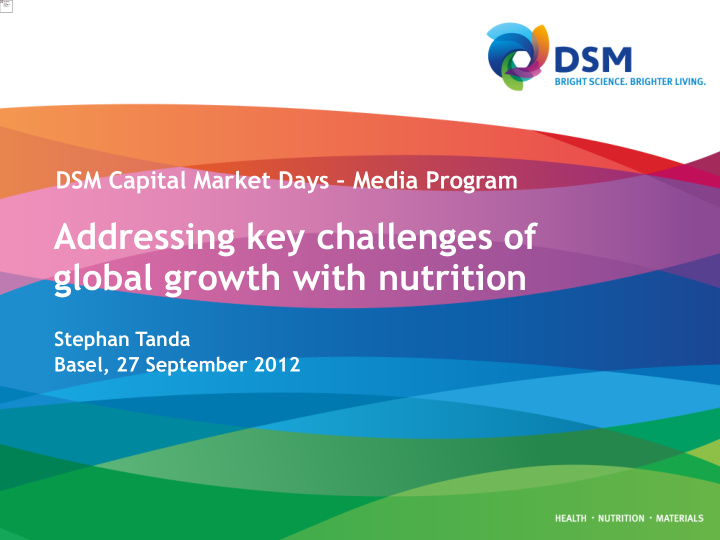



DSM Capital Market Days – Media Program Addressing key challenges of global growth with nutrition Stephan Tanda Basel, 27 September 2012
From 7 billion to 9 billion Page 2
Resource-constrained world Scarcity of food, nutrition, land, water, resources, energy. DSM is helping to address these global challenges, for example with nutritional solutions , as well as with sustainable materials and bio-based products. Page 3
DSM in Nutrition Developed world Human Developing world Use of resources Animal welfare Animal Productivity Environmental impact
DSM in Nutrition Developed world Human Developing world Use of resources Animal welfare Animal Productivity Environmental impact
Longer, healthier, more active lives - DALE Life Expectancy: 80 years Healthy vs. Dysfunctional Life Dysfunctional Life (9.6 yrs.) Healthy Life (70.4 yrs.) Healthy People 2010 2010 - 2050 Number of disabled older persons in and out of institutions will approximately triple!
Effect of vitamins on aging and Non Communicable Diseases (NCD) Vitamin A -Carotene Thiamine Riboflavin Niacin Vitamin B5 Vitamin B6 Vitamin B12 Folate Biotin Vitamin C Vitamin D Vitamin E Vitamin K Dietary AO Multivitamin PUFA Aging Cancer Dementia Bone Health Hypertension Diabetes CVD COPD AMD
Majority of people do not eat the ‘right things’! Adapted from Krebs-Smith et al. 2010 JN Slide 8
Micronutrient intake is inadequate also in Western countries Germany United States United Kingdom The Netherlands Troesch et al BJN 2012
Health benefit platforms drive growth Slide 10
DSM in Human Nutrition Developed world Human Developing world
Human Nutrition, context • 1 out of 7 people go to bed hungry • 2 billion people live with “hidden hunger” (micronutrient malnutrition) • 200 million children are stunted (physical and cognitive) • 3.5 million deaths of children could be prevented with better nutrition in other words: a plane crash every 20 minutes • Rise of nutrition-related diseases: 366 mio people with diabetes • 1.6 billion people are overweight and obese, increasingly also in developing world
The Burden of Knowledge: Nutrition and Cognitive Development • Most brain growth happens in first five years, 80% in first 3 years – we are born with all the nerves we will ever have – brain develops in a clear, pre-programmed time sequence – special, critical periods when things develop extremely fast • Nutrition during first 5 years and especially during the first 1000 days is critical (from conception to two years of age) • Malnutrition during first 1000 days cannot be fixed later • Malnutrition has key impact on NCDs later in life • Proper early nutrition can ad 2 - 3 % of GDP
The Burden of Knowledge Brain neurons in malnourished 3-yr old Brain neurons in normal 3-yr old Source: Dr. Monckeberg in http://www.pediatraldia.cl/01Nueva_carpeta/desarrollo_a.htm
The Impact of Malnutrition Annual lives lost Annual lives impaired 1.1 mio 18 mio babies born children <5 years mentally impaired 600,000 stillbirths 350,000 children 115,000 women go blind 150,000 babies during pregnancy born with neural tube defects Vit. A & Zinc Iron Iron Maternal Vit. A Maternal deficiencies deficiency deficiency iodine deficiency folate anemia anemia deficiency deficiency
Succesful innovations addressing malnutrition Increase micronutrient Lipid-based complementary Innovative approches to content in WFP food supplements with reduce vitamin A food basket, e.g. MixMe™. micronutrients/enzymes. deficiency in India. Slide 17
Innovative approaches to provide nutritional solutions Educational programs for a balanced nutrition combined with fortification Conventional fortification • Staple foods (flour, sugar, milk, oil, rice) • Dairy (milk, yoghurt) • Spreads (margarine) • Condiments (salt) Home fortification • Crushable/soluble tablets • Powder • Spreads Bio-fortification • Agricultural products (rice, maize, sweet potato,…)
Investment in nutrition pays back DEVELOPING WORLD Micronutrient interventions to fight hunger ranked as the number 1 out of 16 investments that should receive top priority GLOBALLY Folate fortification is in place in more than 60 countries and has reduced prevalence of neural tube defects by 50-70 % 19
DSM Partnerships in Human Nutrition Developed world Human Developing world
DSM in Nutrition Developed world Human Developing world Use of resources Animal welfare Animal Productivity Environmental impact
GDP and population growth increase demand for animal products Source: FAO: The State of Food And Agriculture Slide 22
Challenges in animal nutrition Optimize utilization of resources Develop improved & alternative feedstuffs: - Reduction of anti-nutritional factors, - by-products from industrial processes Feed Enzymes Improve health and welfare of farm animals Reduction of morbidity/mortality: Sustain health of high-yielding breeds Increasing longevity: Extend life expectancy of breeding animals Eubiotics
Challenges in animal nutrition (continued) Sustain productivity of farm animals Establish Optimum Vitamin Nutrition: - Exploit genetic potential of high-yielding breeds - End-products with a high nutritional value - Productivity increase in small animal husbandry in developing countries Vitamins and Carotenoids Reduce environmental impact Reduction of ecological footprint: Find solutions for manure and reduce of ammonia & methane emissions Securing resources: Close nutrient cycles (e.g. nitrogen, phosphorus) Novel Concepts
In conclusion • Major challenge to feed a growing world population and satisfy increased demand for protein (meat, milk, egg, fish) • Nutrition and health indisputably linked • Investment in nutrition: guaranteed return for society • DSM can help to address these challenges with human and animal nutrition solutions in developed and developing world • Current DSM nutrition business 4 billion euros and growing • DSM: Doing well by doing good
Recommend
More recommend